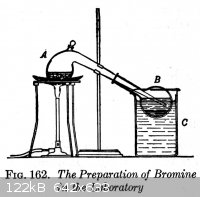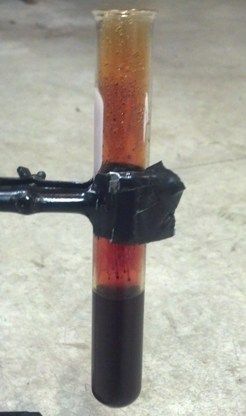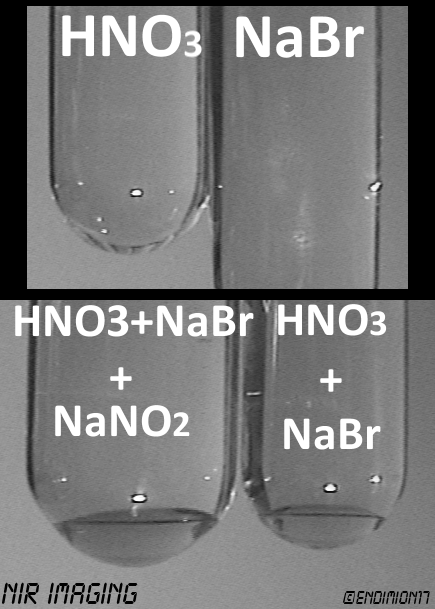<div align="center"><strong>CHAPTER 18<br />The Chlorine
Family<br /><hr width="70" />BROMINE</strong></div> <strong>Preparation of bromine.</strong> The
laboratory method and the industrial method for preparing bromine are as follows:<br /> 1.
<strong><em>Laboratory method.</em></strong> Just as chlorine is set free by the oxidation of hydrochloric acid by manganese
dioxide (p. 203), so bromine may be prepared by a similar reaction, substituting hydrobromic acid for hydrochloric : <table style="float:
right"><tr><td> </td></tr></table><br /><br />4(H<sup>+</sup>, Br<sup>-</sup> </td></tr></table><br /><br />4(H<sup>+</sup>, Br<sup>-</sup> + Mn<sup>++++</sup>, 2 O<sup>--</sup> → Mn<sup>++</sup>, 2
Br<sup>-</sup> + 2 H<sub>2</sub>O + Br<sub>2</sub> ↑<br /><br />Hydrobromic acid is unstable
and on this account is not usually available in the laboratory ; so a mixture of sodium bromide and sulfuric acid is used instead. The equation for
the complete reaction is like the one for chlorine (p. 203) :<br /><br />2(Na<sup>+</sup>, Br<sup>-</sup> + Mn<sup>++++</sup>, 2 O<sup>--</sup> → Mn<sup>++</sup>, 2
Br<sup>-</sup> + 2 H<sub>2</sub>O + Br<sub>2</sub> ↑<br /><br />Hydrobromic acid is unstable
and on this account is not usually available in the laboratory ; so a mixture of sodium bromide and sulfuric acid is used instead. The equation for
the complete reaction is like the one for chlorine (p. 203) :<br /><br />2(Na<sup>+</sup>, Br<sup>-</sup> + 2(2 H<sup>+</sup>,
SO<sub>4</sub><sup>--</sup> + 2(2 H<sup>+</sup>,
SO<sub>4</sub><sup>--</sup> +
Mn<sup>++++</sup>, 2 O<sup>--</sup> → 2 Na<sup>+</sup>,
SO<sub>4</sub><sup>--</sup> + Mn<sup>++</sup>, SO<sub>4</sub><sup>--</sup> + 2
H<sub>2</sub>O + Br<sub>2</sub> ↑<br /><br
/> <strong>Laboratory apparatus.</strong> The materials are placed in a retort,
<em>A</em>, arranged as shown in Fig. 162. The delivery end of the retort dips slightly into the water in flask <em>B</em>,
which is partly immersed in ice water (<em>C</em> +
Mn<sup>++++</sup>, 2 O<sup>--</sup> → 2 Na<sup>+</sup>,
SO<sub>4</sub><sup>--</sup> + Mn<sup>++</sup>, SO<sub>4</sub><sup>--</sup> + 2
H<sub>2</sub>O + Br<sub>2</sub> ↑<br /><br
/> <strong>Laboratory apparatus.</strong> The materials are placed in a retort,
<em>A</em>, arranged as shown in Fig. 162. The delivery end of the retort dips slightly into the water in flask <em>B</em>,
which is partly immersed in ice water (<em>C</em> . As the contents of
the retort are headed, bromine distills over and is collected in the cold receiver.<br /><br />– <em>Introduction to
College Chemistry.</em> McPherson, Henderson, Fernelius, & Quill. Ginn and Company, 1942/46. (<a
href="http://catalog.hathitrust.org/Record/009227908" target="_blank">Hathi Trust</a> <img src="../scipics/_ext.png" /> . As the contents of
the retort are headed, bromine distills over and is collected in the cold receiver.<br /><br />– <em>Introduction to
College Chemistry.</em> McPherson, Henderson, Fernelius, & Quill. Ginn and Company, 1942/46. (<a
href="http://catalog.hathitrust.org/Record/009227908" target="_blank">Hathi Trust</a> <img src="../scipics/_ext.png" /> |





 Now I have a yellow supernatant liquor,
and a small amount of reddish bromine water. Should I start over, and use H2O2 and HCl to get the desired results?
Now I have a yellow supernatant liquor,
and a small amount of reddish bromine water. Should I start over, and use H2O2 and HCl to get the desired results?




















